| Article ID | Journal | Published Year | Pages | File Type |
|---|---|---|---|---|
| 6386532 | Journal of Contaminant Hydrology | 2014 | 36 Pages |
Abstract
Accurately predicting the transport of contaminants in the field is subject to multiple sources of uncertainty due to the variability of geological settings, the complexity of field measurements, and the scarcity of data. Such uncertainties can be amplified when modeling some emerging contaminants, such as engineered nanomaterials, when a fundamental understanding of their fate and transport is lacking. Typical field work includes collecting concentration at a certain location for an extended period of time, or measuring the movement of plume for an extended period time, which would result in a time series of observation data. This work presents an effort to evaluate the possibility of applying time series analysis, particularly, autoregressive integrated moving average (ARIMA) models, to forecast contaminant transport and distribution in the subsurface environment. ARIMA modeling was first assessed in terms of its capability to forecast tracer transport at two field sites, which had different levels of heterogeneity. After that, this study evaluated the applicability of ARIMA modeling to predict the transport of engineered nanomaterials at field sites, including field measured data of nanoscale zero valent iron and (nZVI) and numerically generated data for the transport of nano-fullerene aggregates (nC60). This proof-of-concept effort demonstrates the possibility of applying ARIMA to predict the contaminant transport in the subsurface environment. Like many other statistical models, ARIMA modeling is only descriptive and not explanatory. The limitation and the challenge associated with applying ARIMA modeling to contaminant transport in the subsurface are also discussed.
Keywords
Related Topics
Physical Sciences and Engineering
Earth and Planetary Sciences
Earth-Surface Processes
Authors
Chunmei Bai, Yusong Li,
